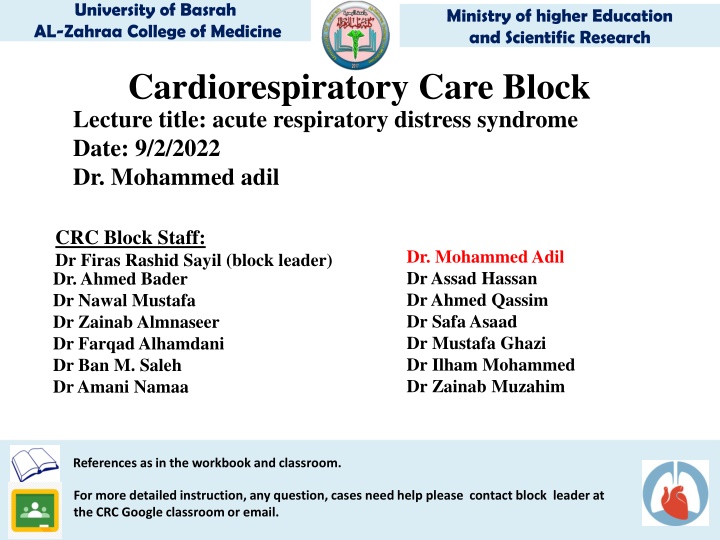
Acute Respiratory Distress Syndrome (ARDS) and Its Management
Explore the definition, pathological stages, classification based on severity, and treatment outline of Acute Respiratory Distress Syndrome (ARDS) as taught in a lecture at the University of Basra, AL-Zahraa College of Medicine. Learn about the causes, severity classification, and the Berlin definition of ARDS to enhance your understanding of this critical clinical condition.
Download Presentation

Please find below an Image/Link to download the presentation.
The content on the website is provided AS IS for your information and personal use only. It may not be sold, licensed, or shared on other websites without obtaining consent from the author. If you encounter any issues during the download, it is possible that the publisher has removed the file from their server.
You are allowed to download the files provided on this website for personal or commercial use, subject to the condition that they are used lawfully. All files are the property of their respective owners.
The content on the website is provided AS IS for your information and personal use only. It may not be sold, licensed, or shared on other websites without obtaining consent from the author.
E N D
Presentation Transcript
University of Basrah AL-Zahraa College of Medicine Ministry of higher Education and Scientific Research Cardiorespiratory Care Block Lecture title: acute respiratory distress syndrome Date: 9/2/2022 Dr. Mohammed adil CRC Block Staff: Dr Firas Rashid Sayil (block leader) Dr Nawal Mustafa Dr Zainab Almnaseer Dr Farqad Alhamdani Dr Ban M. Saleh Dr Amani Namaa Dr. Mohammed Adil Dr Assad Hassan Dr Ahmed Qassim Dr Safa Asaad Dr Mustafa Ghazi Dr Ilham Mohammed Dr Zainab Muzahim Dr. Ahmed Bader References as in the workbook and classroom. For more detailed instruction, any question, cases need help please contact block leader at the CRC Google classroom or email.
University of Basra AL-Zahraa College of Medicine Ministry of higher Education and Scientific Research Learning objective: 1- knowing the definition of ARDS 2- knowing the pathological stages of the disease 3-knowing the classification of ARDS according to severity 4- getting to understand the outline of treatment
University of Basra AL-Zahraa College of Medicine Ministry of higher Education and Scientific Research Acute respiratory distress syndrome (ARDS) is a clinical syndrome of severe dyspnoea of rapid onset, hypoxemia and diffuse infiltrate that may lead to respiratory failure.
University of Basra AL-Zahraa College of Medicine Ministry of higher Education and Scientific Research Berlin definition of ARDS
University of Basra AL-Zahraa College of Medicine Ministry of higher Education and Scientific Research Aetiology: There are many causes of ARDS including : Sepsis Pneumonia Aspiration pneumonia Snake bite Trauma Acute pancreatitis. Multiple transfusion Inhalation injury The most common cause of ARDS are pneumonia and sepsis which causes about 40-50% of cases of ARDS
University of Basra AL-Zahraa College of Medicine Ministry of higher Education and Scientific Research Classification of ARDS severity: ARDS severity can be classified based on PaO2 and FiO2 ,commonly called P:F ratio: Mild ARDS if PaO2/FiO2 in between 200-300. Moderate ARDS if PaO2/FiO2 in between 200-100. Severe ARDS if PaO2/FiO2 less than 100
University of Basra AL-Zahraa College of Medicine Ministry of higher Education and Scientific Research Stages of ARDS: 1- The exudative stage of ARDS: there is an acute injury to alveolar capillary endothelial cells and type I pneumocytes. This results in loss of the normal alveolar barrier with subsequent leakage of protein-rich fluid into the alveoli (noncardiogenic pulmonary oedema). In the early phase, the inflammatory cell infiltrate is predominantly neutrophils. Pathologically, the finding is described as diffuse alveolar damage, Hyaline membranes and loss of type I pneumocytes are seen. The exudative phase of ARDS lasts for approximately the first 7 days of illness.
University of Basra AL-Zahraa College of Medicine Ministry of higher Education and Scientific Research 2- The proliferative phase is second phase of ARDS , which begins around day 7 and continues through day 21. Most patients recover during this phase and are able to be liberated from mechanical ventilation. Histologically, early signs of repair can be seen in this phase with shift to a lymphocyte predominant infiltrate, proliferation of type II pneumocytes, and organization of the alveolar oedema
University of Basra AL-Zahraa College of Medicine Ministry of higher Education and Scientific Research 3- the fibrotic stage of the disease: Only a few individuals who develop ARDS fail to recover during the proliferative phase and continue into the fibrotic stage of the disease. Individuals who develop fibrotic ARDS demonstrate extensive alveolar and interstitial fibrosis at sites of prior alveolar oedema. The acinar architecture frequently becomes distorted, leading to development ofemphysematous changes with large bullae. Fibrotic proliferation may also occur in the intima of pulmonary vasculature, leading to development of pulmonary hypertension.
University of Basra AL-Zahraa College of Medicine Ministry of higher Education and Scientific Research Diagnosis: ARDS can be difficult to distinguish from fluid overload or cardiac failure. ARDS is diagnosed in the presence of acute bilateral pulmonary infiltrates and hypoxemia without evidence of increased left atrial filling pressure.
University of Basra AL-Zahraa College of Medicine Ministry of higher Education and Scientific Research
University of Basra AL-Zahraa College of Medicine Ministry of higher Education and Scientific Research Management: Management of ARDS is supportive, including use of lung-protective mechanical ventilation, inducing a negative fluid balance and treating the underlying cause. Establishing the severity of ARDS is useful, as severe disease will require more proactive management such as prone positioning or extracorporeal membrane oxygenation. the goal is to minimize overdistention of less affected areas of the lungs while maximizing alveolar recruitment. Positive end-expiratory pressure (PEEP) is used to prevent alveolar collapse at end-expiration.
University of Basra AL-Zahraa College of Medicine Ministry of higher Education and Scientific Research Thank you
